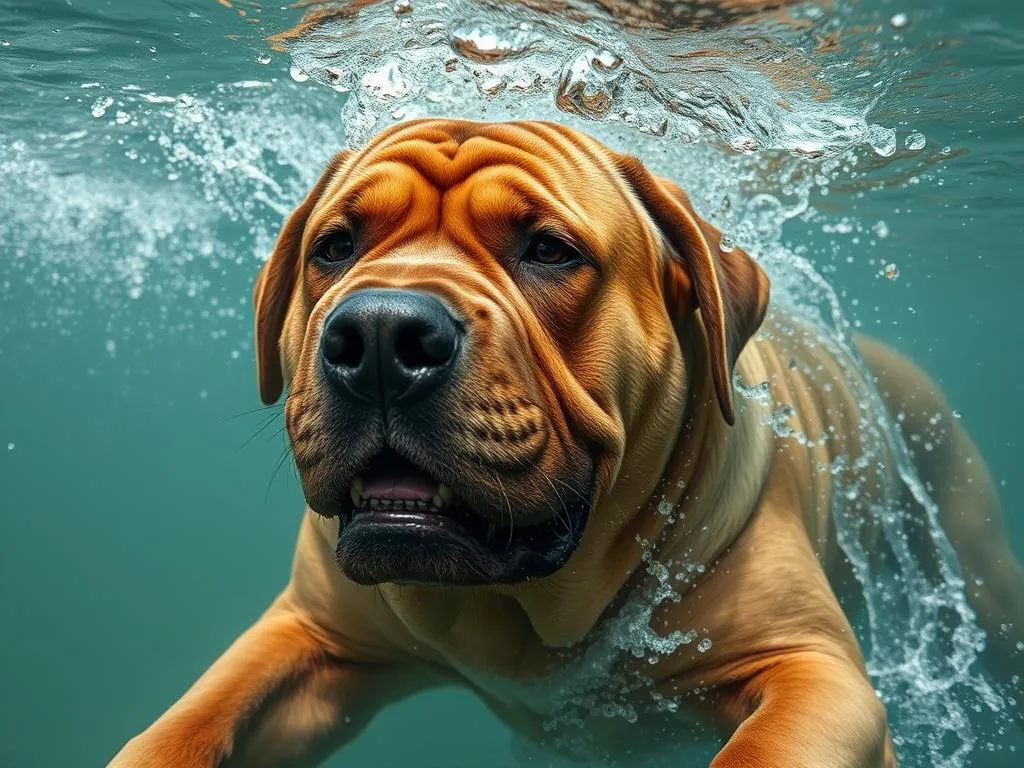
Dog health care is an essential aspect of responsible pet ownership, ensuring that our furry friends lead happy, healthy lives. One activity that stands out for its numerous benefits is swimming. It’s not only a fantastic way for dogs to cool off during hot weather but also serves as an excellent exercise that can improve their physical and mental well-being.
In this article, we’ll delve into the swimming abilities of Mastiffs, a breed known for its size and gentle nature, while also highlighting the health care considerations that come with this activity.
Understanding the Mastiff Breed
Breed Characteristics
Mastiffs are one of the largest dog breeds, often weighing between 120 to 230 pounds. Their imposing size is matched by a calm and affectionate temperament, making them great companions. Despite their rugged exterior, Mastiffs are typically gentle giants, known for their loyalty and protective instincts.
However, they are also predisposed to certain health issues, such as hip dysplasia, heart conditions, and certain types of cancers. Being aware of these common health concerns is essential for any Mastiff owner to ensure their pet lives a long, healthy life.
Mastiff Physical Attributes
The build of a Mastiff can significantly impact its swimming ability. Their broad, muscular bodies provide strength, but their weight can be a disadvantage when it comes to buoyancy. Additionally, Mastiffs have short coats, which do not provide as much insulation or buoyancy as longer-haired breeds. This combination of factors makes them less adept at swimming compared to other breeds.
Swimming as an Activity for Dogs
Benefits of Swimming for Dogs
Swimming is an excellent low-impact exercise that benefits dogs in numerous ways:
- Physical Fitness: Swimming strengthens muscles and improves cardiovascular health without putting stress on joints, which is particularly beneficial for larger breeds like Mastiffs.
- Weight Management: Regular swimming can help maintain a healthy weight, reducing the risk of obesity-related health issues.
- Mental Stimulation: The sensory experience of water can provide mental enrichment, helping to alleviate boredom and anxiety.
- Socialization: Swimming can often be a social activity, allowing dogs to interact with other dogs and people, promoting good behavior and social skills.
Risks of Swimming for Dogs
While swimming has many benefits, it is crucial to recognize the potential risks associated with water activities:
- Drowning: Larger breeds like Mastiffs may struggle with buoyancy, increasing the risk of drowning if they are unaccustomed to water.
- Exhaustion: Swimming can be tiring, especially for larger dogs. Monitoring their energy levels is essential.
- Health Concerns: Mastiffs are prone to certain health issues, such as breathing problems due to their brachycephalic nature. Cold water can exacerbate these issues.
How Well Can a Mastiff Swim?
Swimming Ability of Mastiffs
Historically, Mastiffs were bred for protection and companionship rather than swimming. Their swimming ability is often not as refined when compared to breeds that were developed for water activities, such as Labrador Retrievers. While some Mastiffs can swim quite well, it is not a natural skill for the breed, and many may have an aversion to water.
Factors Affecting Swimming Proficiency
Several factors can impact a Mastiff’s ability to swim:
- Physical Characteristics: The Mastiff’s weight and body structure can hinder buoyancy. Their large heads and broad bodies can create drag in the water, making swimming more challenging.
- Water Comfort Level: A Mastiff’s previous exposure to water plays a significant role in its comfort level. Dogs that have been introduced to swimming at an early age may be more willing to engage in the activity.
Training Your Mastiff to Swim
Training your Mastiff to swim can be a rewarding experience. Here are some tips to help:
- Early Exposure: Introduce your Mastiff to water gradually, starting with shallow areas where they can wade and get used to the sensation.
- Positive Reinforcement: Use treats and praise to encourage your dog when they show interest in swimming. This can help build confidence and reduce fear.
- Supervised Sessions: Always supervise your Mastiff during swimming sessions. Start in shallow water and gradually increase the depth as they become more comfortable.
- Safety Measures: Consider using a dog life jacket, especially in deeper waters or if your Mastiff is a novice swimmer.
Health Care Considerations for Swimming Mastiffs
Pre-Swimming Health Checks
Before taking your Mastiff for a swim, it’s essential to conduct a health check:
- Vet Check-Ups: Regular veterinary visits can help identify any underlying health issues that may impact your dog’s ability to swim safely.
- Health Signs: Look for signs of discomfort, such as coughing or difficulty breathing, which may indicate that swimming is not advisable.
Post-Swimming Care
After a swim, it’s important to take steps to ensure your Mastiff’s health and well-being:
- Cleaning and Drying: Rinse your dog with fresh water to remove chlorine or salt. Dry them thoroughly, especially around the ears to prevent infections.
- Monitoring for Infections: Keep an eye out for signs of ear infections, which can occur in dogs that frequently swim. Symptoms may include shaking their head, scratching at their ears, or a foul odor.
Hydration and Nutrition
Hydration is crucial before and after swimming sessions. Ensure your Mastiff has access to fresh water, particularly after exercise. Additionally, consider the following nutritional points:
- Balanced Diet: A well-rounded diet supports overall health, ensuring your Mastiff has the energy needed for swimming and other activities.
- Weight Management: Monitor your dog’s weight to prevent obesity, which can further limit their swimming abilities.
Conclusion
Mastiffs are unique dogs with distinct characteristics that influence their swimming abilities. While they can swim, they may not excel like breeds specifically designed for water activities. Understanding their physical traits and health considerations is crucial for any owner wishing to introduce their Mastiff to swimming.
Engaging in safe swimming practices, training, and proper health care can enhance your Mastiff’s experience in the water while promoting their overall well-being. With the right approach, swimming can become an enjoyable and beneficial activity for both you and your Mastiff.
FAQs
Can all Mastiffs swim?
While some Mastiffs can swim, not all are natural swimmers. Their size and build can make swimming challenging, and individual comfort levels with water vary.
What should I do if my Mastiff shows fear of water?
Take it slow. Introduce them to water gradually, using positive reinforcement to build confidence. Never force them into the water.
How long can a Mastiff swim safely?
Swimming sessions should be kept relatively short, around 10 to 15 minutes, especially for novice swimmers. Always monitor their energy levels.
Are there specific swimming aids for large breeds?
Yes, dog life jackets designed for larger breeds can help improve buoyancy and keep your Mastiff safe while swimming.









